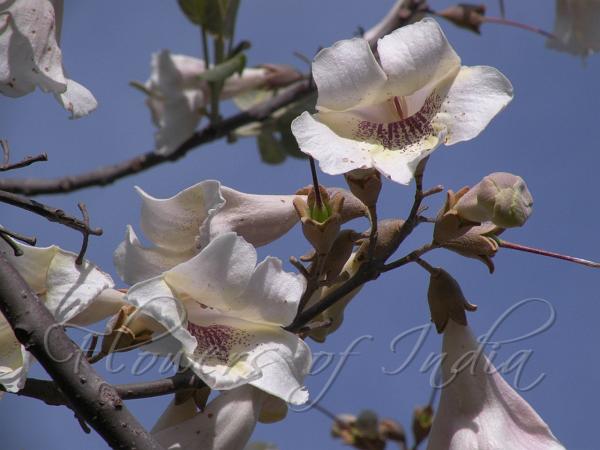|
| Foxglove Tree |
|

|

| File size | 155523 |
| Original date | 3/26/11 8:31 AM |
| Resolution | 1280 x 960 |
| Flash | Flash did not fire, auto |
| Focal length | 50.7mm |
| Exposure time | 1/250s |
| Aperture | 8.0 |
| Focus Distance | |
| Metering Mode | Multi-segment |
| Camera make | NIKON |
| Camera model | COOLPIX P80 |
| Sensor type |
|
|
|
|
Photo: |
Botanical name: Paulownia fortunei Family: Paulowniaceae (Empress Tree family)
Synonyms: Paulownia duclouxii, Paulownia meridionalis, Paulownia mikado
Synonyms: Paulownia duclouxii, Paulownia meridionalis, Paulownia mikado
Foxglove Tree is a tree up to 30 m tall, with a
conical crown. It is closely related to the
Empress Tree Young shoots,
inflorescences, and fruit are yellowish brown velvety. Trunk is
straight, about 2 m d.b.h.; bark gray-brown. Leaf-stalks are about 12
cm, hairless. Leaves are narrowly ovate-heartshaped, occasionally
ovate-heart-shaped, up to 20 cm long, 2-parted on new shoots, hairy
below, velvety when mature, and rarely sparsely hairy or hairless.
Leaves are hairless above. Flowers are borne in narrow and long,
somewhat cylindric thyrses, about 25 cm long. Cymes are 3-8-flowered;
peduncle as long as flower-stalks. Flower-stalks are hairless. Calyx is
obconical, 2-2.5 cm; lobes 1/4-1/3 of calyx length, ovate to
triangular-ovate, narrowly triangular in fruit. Flowers are white,
purple, or light purple, tubular-funnelshaped,
foxglove-like, 8-12 cm ong. Tube is
enlarged gradually, slightly bent forward, ventrally weakly ridged,
outside hairy. Stamens are 3-3.5 cm, sparsely glandular hairy. Ovary
glandular, occasionally stellate hairy. Capsule are oblong to
oblong-ellipsoid, 6-10 cm; beak to 6 cm; pericarp woody, 3-6 mm thick;
persistent calyx 3-6 mm, woody. Seeds 6-10 mm including wing. The genus
Paulownia was named in honour of Queen Anna Pavlovna of The
Netherlands (1795–1865), daughter of Tsar Paul I of Russia. Foxglove
Tree is native to China and SE Asia, occasionally cultivated in India.
Flowering: March-April.
Identification credit: Amit Kumar
| Photographed in Forest Research Institute, Dehradun. |